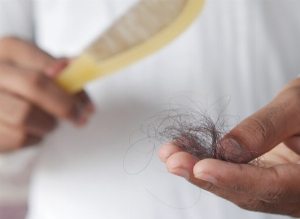Hair loss (alopecia): Everything you need to know!
Published Jul 3, 2023 • By Polina Kochetkova
Alopecia is a medical condition that affects the regular process of hair growth. It is a condition that can be seen in both men and women and results in hair loss. Although alopecia can affect hair on any part of the body, the scalp is where it is most frequently noticed. While the illness can affect anyone at any age, individuals under the age of 30 are the most frequently affected.
What causes hair loss? What are the different types of alopecia? How to treat hair loss?
Keep reading to find out!

Definition of Alopecia
Alopecia is a group of conditions, primarily characterized by hair loss. One of the most well-known types of alopecia is alopecia areata.
Alopecia areata is a condition that results in hair loss when the immune system damages hair follicles. The components in the skin that produce hair are called hair follicles.
Other types of alopecia can be caused by many factors including genetics, environmental factors, diet, lifestyle, and others. People with alopecia usually live pretty healthy lives with little to no other symptoms. Hair loss depends on the type of alopecia the person has and the patterns of hair loss can vary from person to person. In some cases, hair loss can happen with waves of falling out, growing back, and so on. In rare cases, the hair can grow back and not fall out again.
Types of alopecia
Alopecia areata
One or more coin-sized (often round or oval) patches on the scalp or other parts of the body, such as the beard, eyebrows, eyelashes, or body hair, including pubic hair, are typical locations for isolated hair loss that often precedes the development of the alopecia areata, which is an autoimmune disorder. In severe cases, this type of alopecia can cause complete hair loss all over the body. While the exact cause of alopecia areata is unknown, research suggests that it may be related to genetics, environmental factors, or a combination of both.
Immune system cells, specifically T cells known as NKG2D+ T cells, assemble around hair follicles in alopecia areata. These cells attack the follicle, which prevents it from growing new hair. The precise mechanism of this process is not yet known.
Androgenetic alopecia
Scalp hairs often form tufts of three to four hairs. In androgenetic alopecia, the quantity of hairs in each tuft steadily decreases as hair follicles on the body gradually contract (this is referred to as "miniaturization"). The scalp skin eventually shows through hairs until every hair in the tuft has fallen out.
'Male Pattern Hair Loss' or 'Female Pattern Hair Loss' are terms that are frequently used to describe androgenetic alopecia. Most men over the age of 50 and women over the age of 65 have this form of hair loss, which is the most prevalent. Adolescent men and women can also suffer from androgenetic alopecia.
Lichen planopilaris
Scarring alopecia known as lichen planopilaris mostly affects younger women, while it can also affect people of all ages and, less frequently, men. When the immune system destroys the stem cells that keep the hair follicle alive, it causes primary scarring alopecia. The hair follicle is destroyed and replaced by scar tissue as a result. Despite being a rare disorder, Lichen Planopilaris is one of the most frequent reasons for scarring alopecia.
Lichen Planus, which affects the skin, mucosa, and nails, can coexist with lichen planopilaris.
Central centrifugal cicatricial alopecia (CCCA)
Starting on the crown and moving down the top of the head, CCCA boosts hair loss. A 2020 research states that black women over 30 are mostly affected by this type of alopecia, yet it can appear in any gender or ethnicity.
This condition may be caused by a combination of factors, including infections (both bacterial and fungal), inheritance, autoimmune disorders, and other unidentified factors. To determine how much any or all of these factors contribute to the formation of CCCA, more research is required.
Traction alopecia
Traction alopecia is distinct from other kinds of hair loss that are brought on by immunological or genetic causes, such as alopecia areata, scarring alopecias, and androgenetic alopecia. Hair loss from traction alopecia is brought on by stress on the hair follicles, frequently from tight hairstyles. The constant stress on the hair follicles causes sections of hair to fall out and may harm or kill the follicles.
Anyone who pulls their hair back firmly, whether in braids, dreadlocks, or a ponytail, is susceptible to traction alopecia. As well as from using chemical relaxers or even hair extensions, it can also occur when tight headgear (helmet) is worn in the same way every day.
Chemotherapy-induced alopecia
Chemotherapy treatments are potent pharmaceuticals that target the rapid growth of cancer cells. These medications also target the hair roots and other quickly proliferating cells in your body. Two to four weeks after beginning treatment such as chemotherapy, hair loss frequently starts.
The type of chemotherapy medicine you receive will determine how much hair you lose; some chemotherapy drugs do not result in hair loss.
Postpartum alopecia
Postpartum alopecia is a disorder caused by the abrupt and severe decline in estrogen levels that occurs after delivery. Regular hair growth normally returns after a few months.
Alopecia treatments
The treatment for hair loss can vary from patient to patient as alopecia has many different variations. Alopecia may be either temporary or permanent. It could be brought on by family history, hormonal changes, illnesses, or a natural aspect of aging. Even though any person can lose hair on the head, males are more likely to do so.
If you are experiencing persistent hair loss and you would like to seek treatment, do not hesitate to schedule an appointment with your doctor. Discuss early treatment options with your doctor if you're a woman suffering a receding hairline (frontal fibrosing alopecia) in order to prevent major irreversible baldness.
Sudden hair loss may indicate an underlying medical problem that needs to be treated. Therefore, if you notice more hair than normal falling out, it is recommended to chat with a medical professional.
Hair loss caused by a medical condition usually stops once you are recovered.
Treatment for androgenic alopecia
The initial line of therapy for pattern baldness is often over-the-counter treatments you apply to your scalp, such as minoxidil (Rogaine®). Headache, itchy scalp, and unexpected hair growth are a few adverse effects of minoxidil. It is important to know that minoxidil only works while you apply it, yet once you stop the usage, hair can fall out again.
Another option for treating pattern baldness is an oral prescription drug like finasteride (Propecia®). Erectile dysfunction, testicular discomfort, and allergic responses are a few possible adverse effects. This treatment is not suitable for women.
Another popular option is hair transplant surgery. A medical professional performs a hair transplant by moving skin grafts from parts of your body where you have healthy hair to bald or thinning portions of your scalp. Scarring, nausea, dizziness, headaches, and scalp discomfort and irritation are possible side effects.
Lastly, platelet-rich plasma injections can better the situation. To promote hair growth, a medical professional draws blood from your body, prepares it, and injects it into your scalp. Headache, itchiness, nausea, and vomiting are possible side effects.
Natural remedies that can help your hair grow more can include:
- Rosemary oil
The plant's active component, carnosic acid, repairs damaged tissue and nerves. This capacity to regenerate nerve endings may also revitalize scalp nerves, perhaps restoring hair growth.
Recent more revealing studies demonstrate that rosemary contributes directly to the prevention of hair loss. In one research conducted in 2015, Rogaine-brand minoxidil was compared to essential oil. Both treatments were applied to people who had androgenetic alopecia, or male or female-pattern baldness.
The outcomes revealed that rosemary essential oil was equally potent to minoxidil. It worked better than minoxidil to alleviate the adverse effect of an itchy scalp during the procedure.
- Aloe vera
For a very long time, hair loss has been treated with aloe vera. Additionally, it nourishes hair and calms the scalp. It can lessen dandruff and open up hair shafts that may have been clogged with too much oil.
- Coconut oil
Lauric acid, a kind of fatty acid found in coconut oil, penetrates the hair shaft and lowers protein loss from hair.
- Massage
Combining hair oils and masks with scalp massage to stimulate the scalp can increase hair growth.
Treatment for alopecia areata
Currently, there is no cure for this type of hair loss, as it is an autoimmune condition. Yet, there are multiple ways to cope with alopecia areata symptoms.
Corticosteroids are a typical treatment for this type of alopecia. These drugs come in oral pills, topical creams, and injectable forms. The immune system is suppressed by corticosteroids, which can help to lessen inflammation and slow down the progression of hair loss. Although corticosteroids have a chance of working, they can also have negative side effects including weight gain, fluctuations of mood, and elevated blood pressure.
Immunotherapy, which includes applying a chemical irritant to the affected area of the scalp, is another treatment method. The skin becomes irritated by this, triggering an immunological reaction that may encourage hair growth. Side effects of this treatment can include scalp itchiness, scalp turning red, and swelling.
Minoxidil, a topical medicine that is administered directly to the scalp, and low-level laser therapy, which employs red light to stimulate hair growth, are other treatments for alopecia areata. While some patients may benefit from these procedures, not everyone might see results.
Regardless of the approach taken, it is essential for people experiencing hair loss to seek the advice of a medical professional. A dermatologist or trichologist can help to diagnose the underlying cause of hair loss and recommend appropriate treatments. Additionally, supportive therapies, such as counseling or support groups, can help individuals to cope with the emotional impact of alopecia.
Give it a "Like" and share your thoughts and questions with the community in the comments below!
Take care!
Sources:
Hair loss, NHS.uk
Hair loss types: Alopecia areata diagnosis and treatment, AAD.org
Rosemary oil vs minoxidil 2% for the treatment of androgenetic alopecia: a randomized comparative trial, NIH.org
10 Natural Hair Treatment Tips for Hair Growth, Healthline
Types of Alopecia, Alopecia.org
Alopecia - an overview, PCDS.org.uk
1 comment
You will also like

What are the dangers associated with the over-the-counter sale of certain medicines?
Dec 19, 2020 • 6 comments

 Facebook
Facebook Twitter
Twitter


